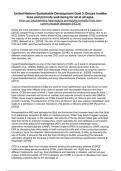United Nations Sustainable Development Goal 3: Ensure healthy
lives and promote well-being for all at all ages.
How can biochemistry help reduce premature mortality from non-
communicable diseases (NCDs)
NCDs are most prevalent in low and medium income countries,(Wurie & Cappuccio,
[2012]), people living in these countries have an increased likelihood of dying, due to an
NCD, before 70 years old. Within these NCDs, cardiovascular diseases (CVD) contribute
the majority of the deaths around the world, followed by chronic respiratory diseases
(CRD), (Bennett et al., [2018]). The aim of this report explores the treatments available for
CVD and CRD, and the mechanisms of the treatments.
CVD is a broad term that includes coronary heart disease, cerebrovascular disease,
hypertension, etc (Karunathilake & Ganegoda, [2018]). At present, there are plenty of
di erent medications used to counter CVD, such as, statins, calcium-channel blockers,
beta blockers, etc.
Hypercholesterolaemia is one of the main factors of CVD, as it leads to atherosclerosis
(Soppert et al., (2020)). Statins are used to lower low density lipoprotein (LDL) by
competitively inhibiting HMG-CoA reductase, HMG-CoA reductase an enzyme used to
limit the rate of cholesterol biosynthesis in the liver (Koushki et al., (2020)). Inhibiting
cholesterol synthesis reduces the amount of cholesterol produced therefore preventing
hypercholesterolaemia, ultimately reducing atherosclerosis (Oesterle, Laufs and Liao,
[2017]).
Calcium-channel blockers (CCBs) are used to treat hypertension and has shown to have
positive, long-term e ects when used in people with myocardial infarction and heart
failure. CCBs are used to block L-type calcium channels by binding onto speci c sites. L-
type calcium channels are found on cardiac and vascular smooth muscle cells (SMCs),
CCBs cause muscle relaxation as CCBs prevent the entry of calcium ions into vascular
smooth muscles. The prevention of the entry of calcium ions also causes vasodilation and
leads to a decrease in vascular resistance, this allows a reduced arterial BP (Rysz et al.,
[2020]).
Norepinephrine (NE) and epinephrine (Epi) are hormones that increase heart rate that bind
to β-adrenergic receptors (β-ARs) on cardiomyocytes. When they bind it triggers a signal
that causes a cascade. In the cascade, Gα subunit of the Gs protein (Gsα) gets activated,
Gsα then binds to adenylyl cyclase (AC), which activates AC and catalyses a conversion,
which converts adenosine triphosphate (ATP) into the second messenger cyclic
adenosine monophosphate (cAMP). Protein kinase A (PKA) is activated by cAMP, causing
PKA to phosphorylate other areas in both contractile cells and in the conduction system,
including L-type Ca channels. Βeta-blockers bind to, and block, β-ARs, by blocking the
site of β-ARs, it prevents NE and Epi from binding to β-ARs, preventing the cascade,
ultimately stopping the increase in heart rate and also preventing hypertension (Grandi &
Ripplinger, [2019]).
CRD is a broad term that includes chronic obstructive pulmonary disease (COPD),
obstructive sleep apnea syndrome (OSA), cystic brosis, etc. Right now, there are
di erent treatments, such as, bronchodilators and steroids in inhalers, central nervous
system (CNS) stimulants, CFTR modulators, etc.COPD is a group of diseases that cause
breathing problems due to the blockage of
ff
ff fi fi





